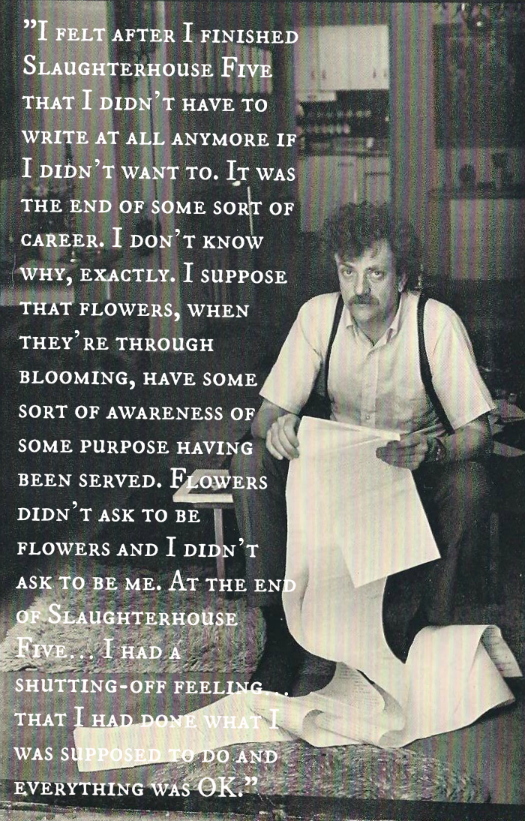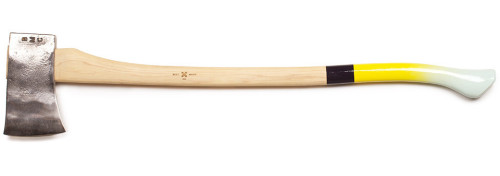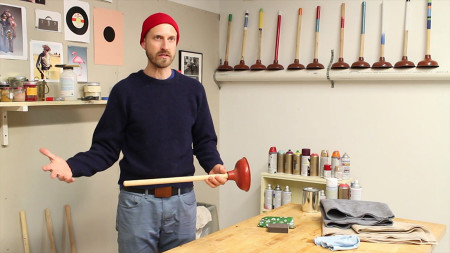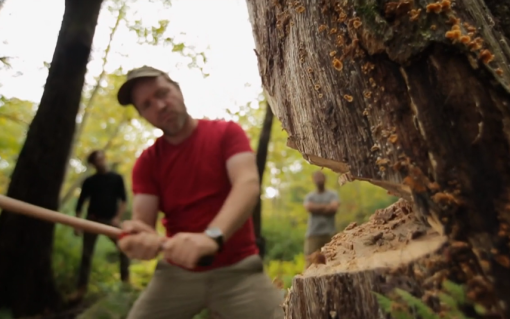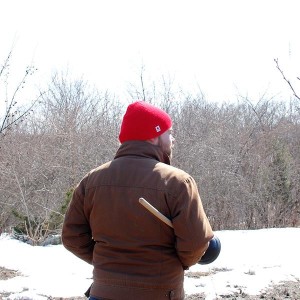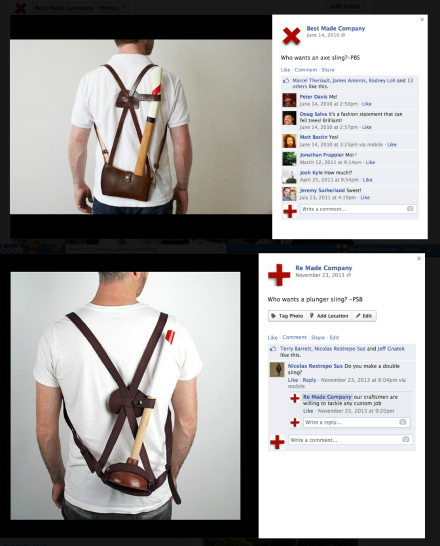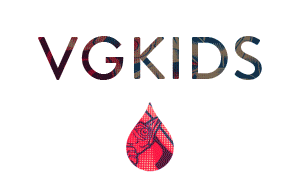Today we’re joined by Peter Sickman-Garner, the cartoonist behind the beloved series Hey, Mister. Pete’s new book, the 192-page graphic novel Come Hell or Highwater Pants, will be be released by Top Shelf this Saturday at the Toronto Comic Art Festival.

MARK: When did you first start drawing? And, what, if you can recall, was the first thing that you ever felt confident enough about to share with others?
PETE: My childhood is kind of a fog. I have no idea what the first thing was that I shared with others, but I do remember making a paperweight in art class, in elementary school. It was supposed to be a Mother’s Day present. I’d made a little statue of my mom as a crazy green monster with snake hair and bug eyes… and her tongue sticking out… and it said “MOM” across the bottom. That was a big hit. I think the thing I take away from childhood is that my parents laughed at all of my jokes, many of which were certainly deeply unfunny. But, of course, I didn’t know that at the time.
MARK: What were your parents like?
PETE: Oh, they’re pretty great. We’re all pretty close. Dad lives around the corner from me, and mom lives in Cambridge, Massachusetts. Like with all my childhood memories, my recollections are all inaccurate because they’re filtered through the last 30 years, so it might be better to just recall facts… They let me stay up and watch Saturday Night Live in 1975 and explained all the jokes that I didn’t get. I remember nights in the kitchen baking bread with my mom and listening to Bob Dylan, and she seemed to love watching Bugs Bunny with me. My dad always coached my baseball teams and taught me how to play tennis (and I was such a little whiner that it must’ve required a lot of patience). They were, and still are, very liberal politically, but didn’t really have much interest in all the partying that went along with being on the left wing back then. My dad, in particular, never suffered fools gladly, but he’s more good-natured about it now than he used to be. I had a million rules when I was very little. Those eventually got pared down to “don’t do anything stupid” by the time I got to high school. I followed that rule to the letter.
They split up after I graduated college. It was an absolute shock, but, really, much easier to manage in my self-medicated 20s than when I was 12, when it probably would’ve seemed like Bedford Falls had suddenly turned into Pottersville overnight.
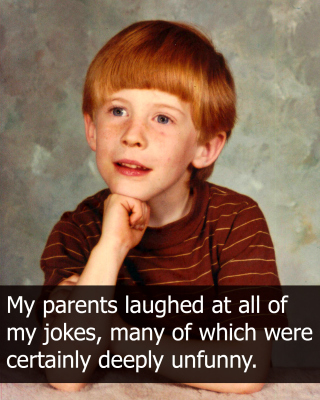 MARK: Other than laughing at all of your unfunny jokes, were they supportive of your artistic endeavors?
MARK: Other than laughing at all of your unfunny jokes, were they supportive of your artistic endeavors?
PETE: They really were, but it was in a very oblique, ‘70s kind of way. Channeling your kid into this or that was way uncool. If there were tiger moms back then, they stayed in the shadows. I certainly showed a fair amount of interest in art, but not much was done about it. When my kids get into something, we figure out lessons and summer camps, etc. It might’ve been good if they’d said, “Hey, dumbass. If you like art, why don’t you take art classes at the public school that our property taxes are already paying for?” But, they never did. They did, however, buy me a drafting table. I do regret missing so many opportunities to just learn how to use the tools, though. I certainly don’t regret not going to art school – that sounds like a uniquely horrible experience, but maybe I’ve just read too much Dan Clowes . I’d just like to not have to figure out everything from scratch. A bit more of a formal foundation would’ve made me a better artist, I think.
. I’d just like to not have to figure out everything from scratch. A bit more of a formal foundation would’ve made me a better artist, I think.
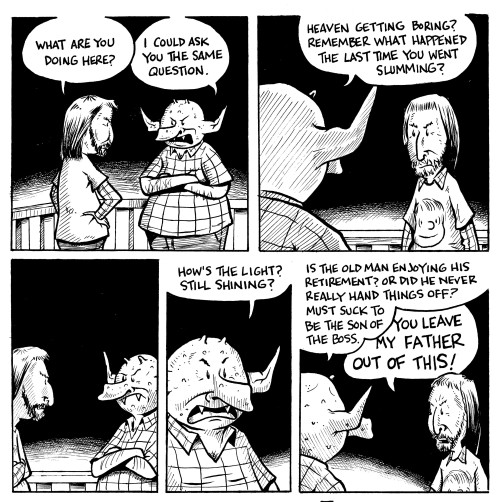
MARK: This is completely unrelated to you or your work, but I’ve been asked to speak at an event in a few days, and I don’t have anything interesting to say. According to the event organizer, I’m supposed to talk about “lies.” Do you have a good story about either a lie that was told to you, or a lie that you yourself told, that I could pass off as my own? (I’ve determined that the best way to talk about lies is by way of plagiarism.)
PETE: When I was about 11 or 12, I was walking up my street to the local park where we all hung out. On the way, I passed about 5 or 6 grocery bags on the curb, and they were full of magazines. Of course I checked them out, and it was all vintage porn. I ran to the park and told my friends. A couple of the guys were older, and they immediately figured that the logical thing to do was start a for-profit lending library for the neighborhood kids. Predictably, it got busted within a couple hours, and I went home waiting for the phone to ring and my parents to come upstairs. I sat in my room rehearsing every possible story I could think of to excuse myself from blame. I waited one day, then another, then another. It was both excruciating and sort of fun to come up with all those crazy lies. And, it was all for naught. Retribution never came. I learned that if you’re committing a victimless crime, and you can get away with it, go for it!
MARK: Do you remember some of the better scenarios you’d worked out to explain your involvement in this neighborhood porn ring?
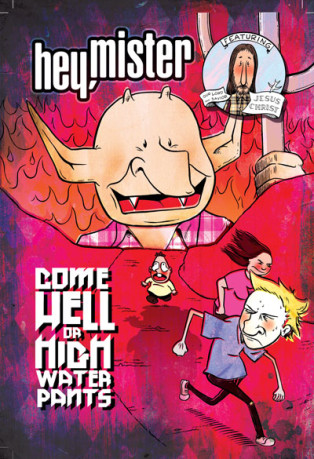 PETE: Well, since I’m a coward, almost all of them hinged on me being coerced into participating by the bigger, older kids, which would’ve been pretty easy given their reputations in the neighborhood and my general pipsqueakiness. But, I was the one who found the comics in the first place, and, as much as I could’ve explained away my eventual non-role in the hijinks, I had to figure out an excuse for that, but I honestly don’t remember what I came up with. If I’d have been smart, I’d have called into question the behavior of the doofus who put a bunch of smut out on the curb. Of course, if we’d had Ebay back then, there was probably some money to be made.
PETE: Well, since I’m a coward, almost all of them hinged on me being coerced into participating by the bigger, older kids, which would’ve been pretty easy given their reputations in the neighborhood and my general pipsqueakiness. But, I was the one who found the comics in the first place, and, as much as I could’ve explained away my eventual non-role in the hijinks, I had to figure out an excuse for that, but I honestly don’t remember what I came up with. If I’d have been smart, I’d have called into question the behavior of the doofus who put a bunch of smut out on the curb. Of course, if we’d had Ebay back then, there was probably some money to be made.
MARK: You could have said that the neighborhood bullies stopped you on your way to the police station, where you intended to drop off the magazines in question, ensuring that they not fall into the hands of the young and vulnerable. Or maybe you could have said that you were taking them to a respected church leader to have them burned.
PETE: My parents would have preferred I read porn than consort with church leaders.
MARK: Do you remember having the “this is where babies come from” talk with your parents?
PETE: I don’t. I actually don’t think it ever happened. Here’s what they did instead. My dad had a study in our house, and one wall was all books. They were in these nice, built-in shelves. At the bottom of one shelf was a little section of my books which consisted entirely of Peanuts and Doonesbury collections, Hardy Boys, and books with titles like Baseball’s Greatest Moments and The Pittsburgh Steelers: A History. Then, one day, some other books showed up in my section. Books like The Joy of Sex and The Hite Report. I have no idea what parental strategy session prompted that decision, but, in retrospect, it’s hilarious. (Sorry, mom and dad!)
MARK: Would I be right to assume that you were a passionate fan of comic books as a kid? If so, was there one in particular that really resonated with you?
PETE: I really never read comic books. When I was pretty small, my parents used to meet their friends at a bar on Friday nights. I only remember joining them once, though there were probably other times. I’m sure I was bored every time, but this one night my dad gave me a quarter and let me go to the newsstand across the street to buy a comic. I went and had no idea what to buy. I came back with an Archie comic, and it made enough of an impression on me because I still remember how horrible it was. Like, I was given a chance to turn a tedious night of listening to grown ups talk into something interesting, and… I blew it. I read it over and over, trying to make it good, and escape the boredom, and it just sucked. I did read comic strips obsessively, though. I started with Peanuts. Then I moved on to Bloom County (my mom made me a kick ass Opus costume for Halloween when I was in high school), Calvin and Hobbes, Far Side, New Yorker cartoons, and Doonesbury, from which I gained a better than average understanding of American history from Viet Nam through Reagan. And, watching Bugs Bunny was key. All of my comic/animation influences were humor based and not genre fiction.
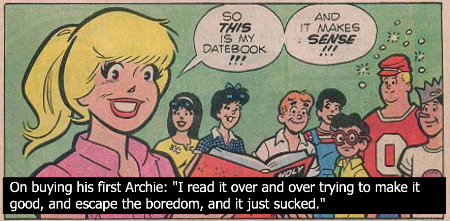
MARK: What was your childhood like?
PETE: Grew up in a college town (State College, Pennsylvania), played and watched sports almost to the exclusion of everything else, happy family (mom, dad, sister, pets). The ’70s were an amazing decade to be a Pittsburgh fan unless you liked hockey. Beyond those facts, all my thoughts about childhood are overly influenced by who I am now. I really have no idea who I was.
MARK: If you could somehow get a message back to your younger self, what would it be?
PETE: Really, really, really don’t care what other people think about you.
MARK: Did you have a hard time fitting in as a kid?
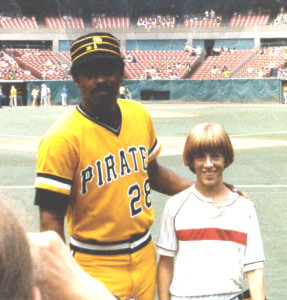 PETE: Sometimes. I never really had a lot of close friends when I was little, but I’m not sure I minded. I know I desperately wanted to be popular and did what I could (without getting in trouble – I never got in trouble) to emulate them. But, I wasn’t very social. All I wanted to do was play sports. I’d go to the park and the guys would all be sitting around and I’d badger them into playing some game, any game. I’m sure I was annoying. When the baseball game ended, I’d try to get them to play basketball, and so on. I didn’t really care who I was with as long as we were playing something. I was like one of those slow-witted dogs who will keep chasing the ball until he dies of heat stroke.
PETE: Sometimes. I never really had a lot of close friends when I was little, but I’m not sure I minded. I know I desperately wanted to be popular and did what I could (without getting in trouble – I never got in trouble) to emulate them. But, I wasn’t very social. All I wanted to do was play sports. I’d go to the park and the guys would all be sitting around and I’d badger them into playing some game, any game. I’m sure I was annoying. When the baseball game ended, I’d try to get them to play basketball, and so on. I didn’t really care who I was with as long as we were playing something. I was like one of those slow-witted dogs who will keep chasing the ball until he dies of heat stroke.
By the time I got to high school, I finally gave up my hopeless attempts to be popular and found a great group of friends who I’m still in touch with. It seems weird to say my high school years were the best of my youth, but they were. All that said, being a grown-up totally kicks ass over being a kid. Tom Waits was wrong.
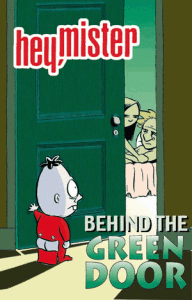 MARK: How did Hey, Mister come about?
MARK: How did Hey, Mister come about?
PETE: I was working at the bookstore and heard from one of the servers in the adjoining coffee shop that the University of Wisconsin Daily Cardinal was looking for someone to do a daily strip, and it didn’t have to be a student. So, I drew up a week’s work, took it to the editor, and got the “job.” (It didn’t pay.) I called it Hey, Mister because I always loved that phrase after I read it in a panel in the Zippy the Pinhead book Are We Having Fun Yet? where Zippy shrinks himself down and then stands outside a liquor store soliciting patrons to buy him beer. I think whenever you use that salutation, you put the person hearing it a bit on guard. It just has a ring of desperation.
where Zippy shrinks himself down and then stands outside a liquor store soliciting patrons to buy him beer. I think whenever you use that salutation, you put the person hearing it a bit on guard. It just has a ring of desperation.
I invented the characters to serve as mouthpieces, to make fun of whatever I wanted to make fun of at the time… most likely sketching them out during tedious shifts working the register when no one was in the store.
After I did the strip every day for three semesters, I’d had enough. (How did Charles Schultz do 50 YEARS?!) I put together all the strips into a book and made copies at Kinko’s, and sold it at Pic a Book. To my great astonishment, they sold, so I made more. Then I pitched it to Capital City Distribution in Madison (back when there was more than just one comics distributor). They put it in their previews catalogs, and, again, to my shock, they came back with an order for 700, or something like that. I stayed up all night copying and stapling with my wife Carol, and carted them to their warehouse in whatever moving boxes I could find in the apartment. They told me I was supposed to have shipped different amounts to each of their distribution locations around the country, but they were nice and did it for me. Then they solicited the five issues of the minicomic I did.
I don’t think something like that could happen today. The distribution system is much more tightly controlled and risk averse. Someone was willing to take a chance on Hey, Mister. My books got out to hundreds of readers at dozens of stores around the country and eventually fell into the hands of the Top Shelf guys.
 MARK: Do you remember the worst meal that you’ve ever eaten? Can you tell us about it?
MARK: Do you remember the worst meal that you’ve ever eaten? Can you tell us about it?
PETE: There are two. Once, when I came home from school, my mom made what sounded like a joke about what we were having for dinner. I responded with something like, “Well, it’s not like we’re having liver.” And we were having liver, which, in all my years before and after, we’d never had. I still wonder what they were thinking.
The other time was a Christmas Eve. Every year, we always had what we called “Hot Pot,” which was just fondue. We had a pot of boiling oil in a cooker in the middle of the table and trays full of meat and veggies that we’d cook in our little baskets and then eat with a bunch of really good sauces. (My parents are fantastic cooks.) Then, one Christmas Eve, all excited about Hot Pot, I came to the table and found a trout on my plate. Not a filet. A whole fish, head to tail. I’m sure it was amazing, but c’mon, mom and dad!
MARK: What makes an idea comic-worthy?
PETE: I think Potter Stewart’s definition of obscenity fits here. “I know it when I see it.” Which is to say, as I’m scribbling in my journal, or just thinking about story ideas, I have a good gut feeling about what will work to flesh out into a story and what won’t. There are always those times where you get an idea that you’re sure is amazing and, when you wake up the next morning, you realize you were deluding yourself. But, over the years, I’ve gotten better and better at only pursuing ideas that I think can work. Or, that I think work. The reader might have a different opinion.
MARK: Assuming that, on occasion, you have great ideas that just don’t fit the narrative voice of Hey, Mister, what do you do with them?
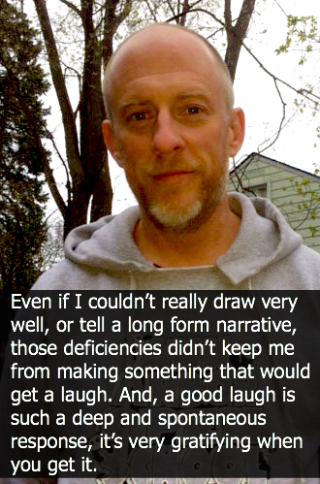 PETE: I have mountains of old journals and yellow legal pads and random scribbles and bits of stories or jokes. I slog through them every once and a while. I’m probably getting close to the point where I’ll start drawing more non-Hey, Mister ideas. I have one in the works about what would happen if I bought my dog a jet pack. (hint: It’s sad.)
PETE: I have mountains of old journals and yellow legal pads and random scribbles and bits of stories or jokes. I slog through them every once and a while. I’m probably getting close to the point where I’ll start drawing more non-Hey, Mister ideas. I have one in the works about what would happen if I bought my dog a jet pack. (hint: It’s sad.)
MARK: Did you ever publish something and regret it later?
PETE: Regret is probably too strong a word. I’ve got old stories that make me cringe a little when I read them, so I just don’t. The biggest hurdle to get over when you first start writing or drawing is drowning out that part of your brain that is telling you that you’re terrible. Because, really, when you’re first starting out at something like comics, you are terrible. The first time you put pen to paper, you know you’re doing something that you’d like to get better at. But, you have to feel like you’re at least good enough to spend hours and hours on a story and have it be worth it. That probably explains why humor comics have always been my focus. Even if I couldn’t really draw very well, or tell a long form narrative, those deficiencies didn’t keep me from making something that would get a laugh. And, a good laugh is such a deep and spontaneous response, it’s very gratifying when you get it.
MARK: Do I understand correctly that you once did cover art for my friend Jeff’s zine Temp Slave? How’d that come to pass?
PETE: That’s another good question that I’m not 100% sure about. I think we must’ve met at Pic-a-Book, the Madison newsstand that sold Temp Slave and my comics. Or we met when he came into the bookstore I worked at, Canterbury Booksellers, to see if we’d sell his zine. I didn’t know anyone in comics or zine publishing then, and it wouldn’t have been out of the question for me to ask if I could draw the cover of his next issue. I ended up doing the cover for issue 9. Then, after I moved to Arkansas, I got a job at a publisher. Jeff and I had stayed in touch, and, when he needed someone to layout his book , and do spot illustrations and the cover design, I was able to help out (thanks to the actual book design experts at the University of Arkansas Press, Gail Carter and Liz Lester).
, and do spot illustrations and the cover design, I was able to help out (thanks to the actual book design experts at the University of Arkansas Press, Gail Carter and Liz Lester).
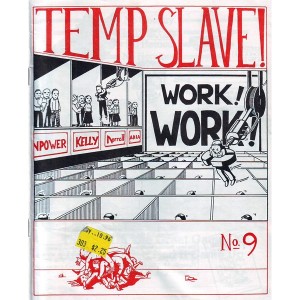 MARK: As the subject of religion has come up a few times, I’m curious as to your thoughts on the 700 Club?
MARK: As the subject of religion has come up a few times, I’m curious as to your thoughts on the 700 Club?
PETE: Is that the one with Pat Robertson? I should know that because I spent enough time watching televangelists as a kid. I think Jimmy Swaggert was my favorite. I’ve always wondered if my parents worried every time they heard that stuff coming from the TV room. It was all morbid curiosity and nothing else. But, given the religious vacuum I was raised in, seeing those people talking their crazy talk, stomping back and forth on stage, getting all worked up… that’s entertainment! When we moved to Arkansas there was a preacher on every other channel and, with the exception of Jack and Rexella Van Impe, I lost interest.
MARK: And, as I understand it, you have the distinction of being the first person to be published by Top Shelf, in 1997… Were they friends of yours?
PETE: I met them at the Small Press Expo in Bethesda (which remains my favorite show to attend) and they were just throwing around the idea of creating a press that published collected works of artists who were doing self-published minis. I’d previously sent a story to Brett Warnock for consideration in the anthology that he’d been putting out at the time, which was called Top Shelf. So, after I met them, they agreed to collect my minis in a trade paperback. It’s old and raw and hard to read in some places because I was drawing different stories on different sized sheets of paper and not everything translated well to the 5.5″ x 8.5″ format. But, it’s a pretty good snapshot of my obnoxious late-20s.
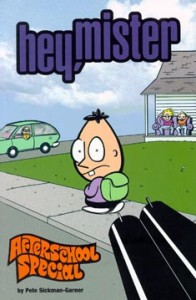 I got the mistaken impression that they were planning to put out all my books. Not just collections of self-published work but all my new single issues as well. So, I called and said “I’ll have a new book done in a couple months,” and they said “okay,” because I think they were too nice to let me down. So, they started publishing single issues of Hey, Mister and collected them whenever they had enough pages to do a trade paperback.
I got the mistaken impression that they were planning to put out all my books. Not just collections of self-published work but all my new single issues as well. So, I called and said “I’ll have a new book done in a couple months,” and they said “okay,” because I think they were too nice to let me down. So, they started publishing single issues of Hey, Mister and collected them whenever they had enough pages to do a trade paperback.
MARK: What’s your process like?
PETE: It changes with everything I write. But I always spend a lot of time on the writing. I have so little connection to other writers and cartoonists that I don’t know what to compare it to but I think it resembles writing an ensemble comedy. I start by plotting the action until it is fully formed, beginning to end, but the details are still very loose. Once I’ve figured out what plot points I have to hit, I start storyboarding and sketching in dialogue. The dialogue gets refined and, I hope, funnier, with every iteration, and I keep improvising right up until I do final penciling and final inking. You just never know when a good joke or bit is going to hit you, so I try to not commit until the very end.
MARK: I’m not sure why, but I like to ask people about their work spaces. Do you have a place in your home where you do your drawing? Can you send a photo?
PETE: I can send photos, but it’ll either be my dining room table, kitchen counter or my lap. I used to have a dedicated drawing table and space in the house, but it’s a hulking piece of furniture and takes up too much space now that I no longer sit and draw for hours.
MARK: Yes, please send photos of your lap.
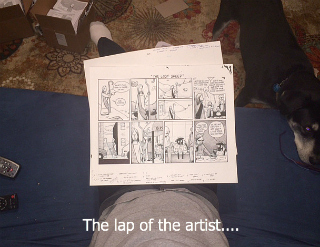 PETE: Done!
PETE: Done!
MARK: You have a new book coming out. I’ve yet to read it. I hear, however, Satan figures prominently…
PETE: The idea that Satan was a friend of my characters predates almost all of Hey, Mister. So, when I decided to bring him back, he was coming to a world with it’s own internal logic. Then, there was my obsession with Jesus. How do I work him in? Let’s see if I can do a 30-second pitch. Oh, hell, Top Shelf’s very, very talented Leigh Walton has done it for me (really, as a former copywriter, I will say I couldn’t do my own book better): “Meet Satan. After eons of ruling the underworld, he’s sad as Hell and can’t take it anymore. So why not skip town and check out “the air up there”? He can shack up with old pals Mister, Young Tim, and Aunt Mary — but we all know slacker roommates can lead to friction in the long term… Meanwhile, Jesus Christ is wrestling with his own midlife crisis, not to mention the world’s biggest daddy issues. With Satan’s time on earth running out, and Hell breaking loose in his absence, it’s time for a road trip down below! Can our heroes save a sinner’s soul without pissing off the Powers That Be?”
Basically I had the idea for Satan to be “the guest who wouldn’t leave” but that’s not really a story, and I really wanted to write something that read like a caper. So, I invented the idea that Satan was planning to stay on earth, but to do that he had to steal his soul back from God. And, he enlists a somewhat hapless Jesus to help him, which works nicely since redeeming Satan would be the ultimate act for the Holy Redeemer. That’s the elevator pitch.
MARK: Any advice to young people trying to get started in the world of comics today?
PETE: Don’t ever calculate your hourly wage.
Read a lot and learn how to tell a story. And, learn how to be a really good renderer. Do what Charles Schultz did and keep a journal where you just draw page after of page of sets of the same object (3 ball gloves, 3 shovels, etc). Autobiographies aren’t interesting unless they have the same narrative force as good fiction. You can’t just relate the events of your life or describe how you feel and expect anyone to care. Also, learn how to do basic web-programming. And if you can figure out how to make money with comics on the internet, you’ll have a army of comics dinosaurs paying you for advice.
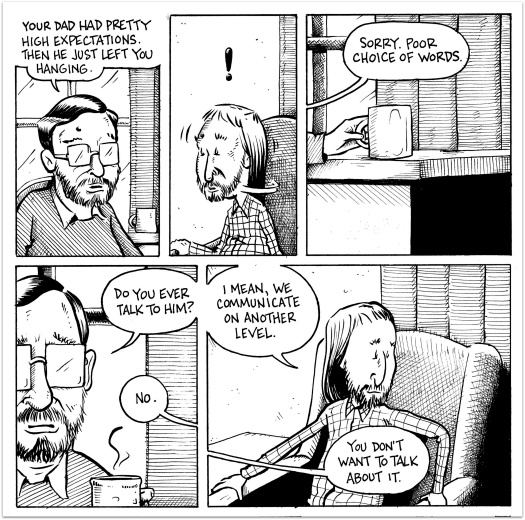
[note: In addition to the new graphic novel on Top Shelf, Pete also has a new self-published book coming out with two new Jesus stories and a screen printed cover from our friends at VG Kids. I’m told they’ll be for sale at Vault of Midnight next week. Just look for the minicomic with “Pissed Christ” on the cover.]

